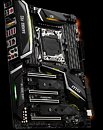Raevenlord
News Editor
- Joined
- Aug 12, 2016
- Messages
- 3,755 (1.17/day)
- Location
- Portugal
| System Name | The Ryzening |
|---|---|
| Processor | AMD Ryzen 9 5900X |
| Motherboard | MSI X570 MAG TOMAHAWK |
| Cooling | Lian Li Galahad 360mm AIO |
| Memory | 32 GB G.Skill Trident Z F4-3733 (4x 8 GB) |
| Video Card(s) | Gigabyte RTX 3070 Ti |
| Storage | Boot: Transcend MTE220S 2TB, Kintson A2000 1TB, Seagate Firewolf Pro 14 TB |
| Display(s) | Acer Nitro VG270UP (1440p 144 Hz IPS) |
| Case | Lian Li O11DX Dynamic White |
| Audio Device(s) | iFi Audio Zen DAC |
| Power Supply | Seasonic Focus+ 750 W |
| Mouse | Cooler Master Masterkeys Lite L |
| Keyboard | Cooler Master Masterkeys Lite L |
| Software | Windows 10 x64 |
Toppc Pushes the X299 Gaming Pro Carbon AC Motherboard to Reach New DDR4 Frequency Milestone
One year ago, MSI's in-house overclocker, Toppc, broke the DDR4 5GHz barrier using G.SKILL memory and the MSI Z170I GAMING PRO AC motherboard. Today, 1 year later, he raises the bar once again and became the first ever to push DDR4 speeds to 5.5GHz under liquid nitrogen cooling using the new MSI X299 GAMING PRO CARBON AC motherboard. With the MSI X299 GAMING PRO CARBON AC, MSI's most customizable high-performance Intel X299 based motherboard, Toppc was running G.SKILL DDR4 memory with an unbelievable DDR4-SDRAM clock speed of 5500MHz. This world record shows MSI's dominant position on performance for X299 by using MSI's unique and patented DDR4 Boost technology. The MSI X299 GAMING PRO CARBON AC is not only feature packed for gamers and great for case modding, it is also perfectly suited to deliver power for heavy gaming & overclocking sessions.




X299 Gaming Pro Carbon AC: Perform in Style
The world's first motherboard with fully exchangeable heatsink covers and X-Mounting accessories to support 3D printing and modding, combined with the latest generation MYSTIC LIGHT RGB LEDs, makes the X299 GAMING PRO CARBON AC any modders' dream!

Just activate the one-second Game boost function and performance raises to the next level like manual overclocking, without breaking a sweat. Furthermore, with the addition of 2x M.2 Shield, any fast PCI-Express SSD is sure to deliver maximum performance. With Turbo M.2 and Turbo U.2, simply connect any of the latest generation NVMe based SSDs with ease, providing you a lighting fast storage transfer experience. With unlimited customization options and packed with exclusive gaming features, the renowned GAMING PRO CARBON is ready to astonish once again in any gaming build
View at TechPowerUp Main Site
One year ago, MSI's in-house overclocker, Toppc, broke the DDR4 5GHz barrier using G.SKILL memory and the MSI Z170I GAMING PRO AC motherboard. Today, 1 year later, he raises the bar once again and became the first ever to push DDR4 speeds to 5.5GHz under liquid nitrogen cooling using the new MSI X299 GAMING PRO CARBON AC motherboard. With the MSI X299 GAMING PRO CARBON AC, MSI's most customizable high-performance Intel X299 based motherboard, Toppc was running G.SKILL DDR4 memory with an unbelievable DDR4-SDRAM clock speed of 5500MHz. This world record shows MSI's dominant position on performance for X299 by using MSI's unique and patented DDR4 Boost technology. The MSI X299 GAMING PRO CARBON AC is not only feature packed for gamers and great for case modding, it is also perfectly suited to deliver power for heavy gaming & overclocking sessions.




X299 Gaming Pro Carbon AC: Perform in Style
The world's first motherboard with fully exchangeable heatsink covers and X-Mounting accessories to support 3D printing and modding, combined with the latest generation MYSTIC LIGHT RGB LEDs, makes the X299 GAMING PRO CARBON AC any modders' dream!

Just activate the one-second Game boost function and performance raises to the next level like manual overclocking, without breaking a sweat. Furthermore, with the addition of 2x M.2 Shield, any fast PCI-Express SSD is sure to deliver maximum performance. With Turbo M.2 and Turbo U.2, simply connect any of the latest generation NVMe based SSDs with ease, providing you a lighting fast storage transfer experience. With unlimited customization options and packed with exclusive gaming features, the renowned GAMING PRO CARBON is ready to astonish once again in any gaming build
View at TechPowerUp Main Site





 But, I won't call anyone out for this, the forums are casual conversation after all.
But, I won't call anyone out for this, the forums are casual conversation after all.
